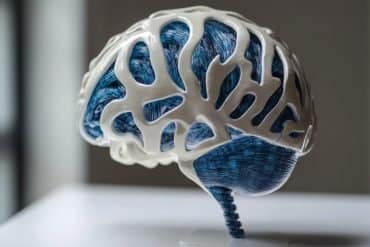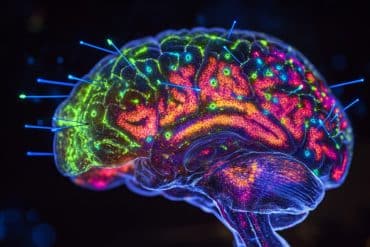Summary: Glutamatergic neural connections between the prelimbic prefrontal cortex and nucleus accumbens appear to be responsible for co-morbid anxiety and OCD behaviors.
Source: Nanjing University
Anxiety disorders and obsessive-compulsive disorder (OCD) are disabling psychiatric conditions and the major contributors to global burden of nonfatal illness. The lifetime prevalence of anxiety disorders in adults under 60 years ranged from approximately 30-35%, whereas the lifetime prevalence of in the general population is estimated at 2-3% for full OCD but over 25% for OCD symptoms.
OCD is characterized by uncontrollable, reoccurring thoughts (called obsessions) and/or ritualized, repetitive behaviors (compulsions) that are aimed at getting rid of the obsessions and seeking relief from the anxiety caused by obsessions, indicating a close correlation between anxiety and OCD.
Indeed, anxiety disorders have been reported epidemiologically as the most frequent comorbid conditions with OCD. Therefore, common pathologies may be present in anxiety disorders and OCD, and elucidation of the shared neural substrates will lead to greater insight into their pathophysiology and treatment.
In a study recently published in PNAS, Dr. Jing-Ning Zhu’s group in Nanjing University reports that a glutamatergic neuronal circuitry from the prelimbic prefrontal cortex (PrL) to the nucleus accumbens (NAc) core is responsible for co-occurrence of anxiety- and obsessive-compulsive-like behaviors. Notably, activation of the histamine presynaptic H3 heteroreceptor localized in the PrL-NAc glutamatergic terminals ameliorates stress-induced anxiety and obsessive-compulsive-like behaviors.
The nucleus accumbens (NAc) is a well-known brain structure in the basal ganglia limbic loop, which is critical for the emotional and motivational regulation. Deep brain stimulation (DBS) targeting the NAc core has been found to improve obsessive-compulsive symptoms and decrease ratings of anxiety in patients suffering from treatment-resistant OCD or depression.
In previous studies, Jing-Ning Zhu’s group has reported that DBS can induce an increase in histamine release in the subthalamic nucleus to alleviate Parkinsonian motor deficits. Here, they create a new transgenic rat strain expressing Cre recombinase in the histamine-producing neurons, restrictedly localized in the tuberomammillary nucleus of the hypothalamus, and find that selective optogenetic activation of histaminergic afferent inputs in the NAc core remarkably improves anxiety as well as obsessive-compulsive-like behaviors induced by restraint stress.
The amelioration effects of histamine on anxiety and obsessive-compulsive-like behaviors are mediated by the suppression of glutamatergic rather than GABAercigc transmission in the NAc core via presynaptic H3 heteroreceptors. Although the authors reveal that histamine H3 presynaptic receptor is expressed and localized in the glutamatergic terminals in NAc core from the PrL, basolateral amygdala, and ventral hippocampus, only the PrL-NAc pathway is the circuit mediating the co-occurrence of anxiety- and obsessive-compulsive-like behaviors.

Chemogenetic inhibition of the PrL-NAc glutamatergic circuit significantly prevents the anxiogenic and obsessive-compulsive-like behaviors induced by acute restraint stress. Interestingly, microinjection of histamine or selective H3 receptor agonist RAMH locally into the NAc core alleviates both anxiety- and obsessive-compulsive-like phenotypes induced by optogenetic activation of PrL-NAc glutamatergic circuit.
Effective pharmacological interventions for the comorbidity of anxiety and OCD are still lacking. Presynaptic histamine H3 receptor, selectively acting on glutamatergic neurotransmission, may provide a potential target for the treatment of anxiety and OCD. Notably, several agonists for H3 receptor, including RAMH and its prodrugs, have entered clinical trials and been proved safe. Therefore, developing strategies, such as pharmacological and/or DBS therapy, for targeting H3 receptor/histaminergic afferents in the NAc core or PrL-NAc glutamatergic circuit may pave a new path for clinical treatment of anxiety disorders and OCD.
Funding: The work was supported by the grants 32030044, 31961160724, 81671107, 81971263, 31600834 and 31500848 from the National Natural Science Foundation of China; and the grants BK20190008 and BK20180057 from the Natural Science Foundation of Jiangsu Province, China.
About this anxiety research news
Source: Nanjing University
Contact: Jing-Ning Zhu – Nanjing University
Image: The image is in the public domain
Original Research: Closed access.
“Targeting presynaptic H3 heteroreceptor in nucleus accumbens to improve anxiety and obsessive-compulsive-like behaviors” by Jing-Ning Zhu et al. PNAS
Abstract
Targeting presynaptic H3 heteroreceptor in nucleus accumbens to improve anxiety and obsessive-compulsive-like behaviors
Anxiety commonly co‐occurs with obsessive-compulsive disorder (OCD). Both of them are closely related to stress. However, the shared neurobiological substrates and therapeutic targets remain unclear. Here we report an amelioration of both anxiety and OCD via the histamine presynaptic H3 heteroreceptor on glutamatergic afferent terminals from the prelimbic prefrontal cortex (PrL) to the nucleus accumbens (NAc) core, a vital node in the limbic loop. The NAc core receives direct hypothalamic histaminergic projections, and optogenetic activation of hypothalamic NAc core histaminergic afferents selectively suppresses glutamatergic rather than GABAergic synaptic transmission in the NAc core via the H3 receptor and thus produces an anxiolytic effect and improves anxiety- and obsessive-compulsive-like behaviors induced by restraint stress. Although the H3 receptor is expressed in glutamatergic afferent terminals from the PrL, basolateral amygdala (BLA), and ventral hippocampus (vHipp), rather than the thalamus, only the PrL– and not BLA– and vHipp–NAc core glutamatergic pathways among the glutamatergic afferent inputs to the NAc core is responsible for co-occurrence of anxiety- and obsessive-compulsive-like behaviors. Furthermore, activation of the H3 receptor ameliorates anxiety and obsessive-compulsive-like behaviors induced by optogenetic excitation of the PrL–NAc glutamatergic afferents. These results demonstrate a common mechanism regulating anxiety- and obsessive-compulsive-like behaviors and provide insight into the clinical treatment strategy for OCD with comorbid anxiety by targeting the histamine H3 receptor in the NAc core.







